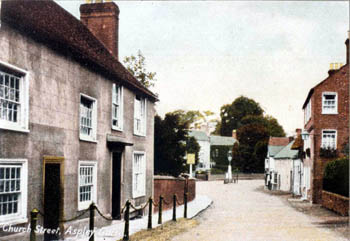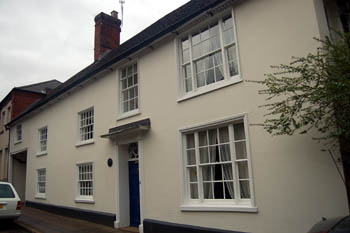Chain House Aspley Guise

Chain House, showing the reason for its name, around 1920 [Z818/2]
Chain house lies between the Anchor public house and the Powage Press in Church Street. It was listed by the former Ministry of Works in 1961, which considered it to be late 18th century "probably refronting of earlier building". The exterior is colour-washed and rendered, perhaps over some timber-framing. The roof is made of clay tiles and the house forms an L shape of two storeys.
Today Chain House is a single dwelling. In 1927 this part of Bedfordshire was valued under the terms of the Rating Valuation Act 1925; every piece of land and building had to be inspected to determine the rates to be paid on it. At this date Chain House was divided into two. The whole structure was owned by F.Albert Pickering, who lived in the larger part, the longer stroke of the L, in effect, nearest the Anchor. The valuer describes the building [DV1/C/138/33] as cement faced, tiled and semi-detached. He noted two living rooms, a kitchen, scullery, pantry and cellar downstairs, with three bedrooms, a bathroom and wc above, with two attics above that. Outside were a timber and thatch barn, corrugated iron harness room, timber and corrugated iron store, workshop, cellar, coach house, stable and hovel. He commented: "Right in centre of village. Double fronted. Old Farmhouse type with long back addition". Mains water and drainage were laid on as was a supply of gas.
In the shorter stroke of the L, next to The Powage Press, lived Pickering's tenant Harry Checkley. He occupied two living rooms and a kitchen dowstairs, with two bedrooms above and three attics above that. Outside were a barn and wc. Mains water and drainage was laid on. The valuer noted, somewhat enigmatically: "Rotten at back".
Directories reveal that prior to Albert Pickering and Harry Checkley Chain House was occupied by a Mrs.Anderson, in 1920 and a Miss Veasey, in 1914. The chains which gave the house its name were removed during the Second World War due to the national need for scrap metal.
 Chain House January 2008
Chain House January 2008